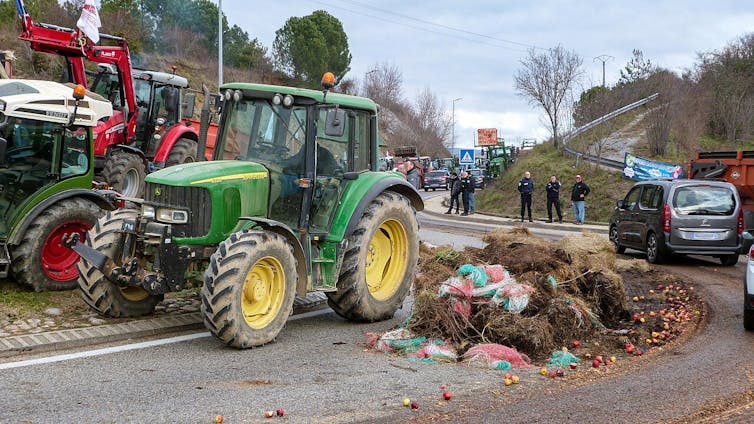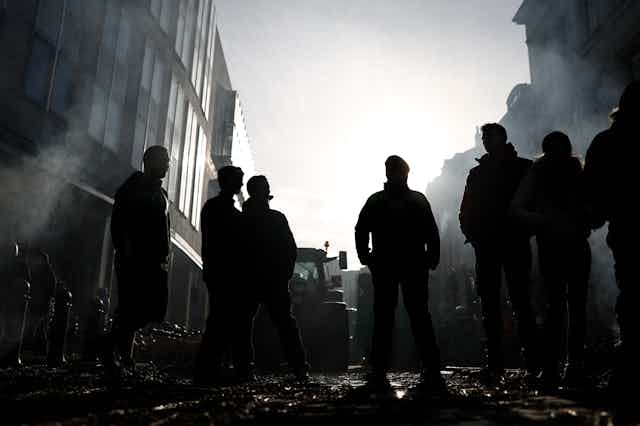For days, those images of farmers were all you could see on TV. The script was well-worn one: farmers leaving their farms to block roads and roundabouts, and checking on refrigerated lorries. They converged in Paris or Brussels, but also set up shop throughout Europe outside government quarters, camping tractors and forestry trucks at junctions and on motorways.
Are these examples of yet another agricultural crisis? Or is it better to read them as a modern version of France’s Jacqueries, the peasants’ revolt against the nobles that took place in northern France in 1357–8? Perhaps not. It’s true that the anger of the farming community is expressed in waves, depending on price trends or climate disasters. But observers of the sector note that this crisis differs from previous ones for at least two reasons.
On the one hand, there has been a rather unusual convergence of all the farming unions on the ground, with similar if not common demands. And for the first time in history, the demonstration is becoming “coordinated” at European level since almost all the countries have experienced social movements linked to the agricultural world at the same time. Previously, these were often local and concerned only one sector (milk, meat, etc.): until now, no agricultural crisis has had such cohesion.
A cursory glance at the situation might lead us to believe that agricultural crises follow one another with varying frequency. In truth, the agricultural world has been in a permanent crisis for the last 20 years. At its root: the gradual dismantling of the original Common Agricultural Policy (CAP). Dating back to 1962, the CAP was set out in the Treaty of Rome of March 1957, one of the bedrocks of the European Economic Community (EEC). It had the distinctive feature of being genuinely common and, above all, of offering producers a steering wheel and safety nets.
Fewer guarantees against unforeseen events
At its beginnings, the European policy had boasted ambitious goals: increased competitiveness, security of supply, more stable markets and decent incomes for farmers. It was a common policy because it had regulatory tools at European level that enabled the EEC Member States to think about their agricultural policy not only at a national level, but also supranational one.
Market regulation was the first pillar of the CAP. Annual quotas were defined at a European level and then broken down by country and then by individual farms. These mechanisms offered farmers a degree of visibility and relative price stability, which was reassuring for a sector that was subject to climatic hazards and diseases. The European regulation also controlled production volumes and by extension, prices. The theory was that policy-makers would chip away it year after year until quotas officially disappeared in 2015.
Accounting for a quarter of the CAP budget, the second pillar of agricultural policy supports rural development and occasionally helps to influence production through aids and subsidies. The last sectors to be governed by quotas were milk and sugar, while the fruit and vegetable sectors abandoned them much earlier. This deprived the CAP of a powerful lever. Europe, now having embarked on a more liberal path, has in fact favoured a more open and deregulatory approach that, for many observers, has given way to more volatility in agricultural commodity markets.

As a result, European agricultural markets have slackened, with the lack of regulation at a European level (particularly on volumes) prompting intra-European competition that can be damaging. Farmers, pitted against each other when they used to know who would produce what volume for what remuneration, have been unable to compensate for the erosion of prices and have had to grapple with more uncertain incomes. In concrete terms, Irish milk found itself in direct competition with Danish, Belgian and French milk. As our research shows, this has led the major cooperatives and manufacturers to enter into a race for size in order to pre-empt markets and take up positions.
Some sectors have subsequently experienced crises of overproduction, leading to a collapse in prices. What’s more, since Europe no longer allows strategic food stocks (even though their usefulness was demonstrated during the Covid crisis) markets are left without the buffering or cushioning mechanisms that existed in the past.
Forcing to negotiate (in an unfavourable position)
The destabilisation of the market impacts upon all the links in the agricultural chain: each player will have a strategic interest in hedging its position by shifting part of its problems and the risks inherent in the sector to another player (for instance in grain or milk markets, industrial or distributors tends to deport the volatility of international prices on farmers since they are not able to bargain on prices and volumes). This goes some way to explaining why trade negotiations within agricultural sectors are often tense, with everyone trying to preserve their margins at someone else’s expense.
The centre of gravity of market regulation has thus shifted from Europe and its common tools to national and international markets, giving free rein to unbalanced power relations. Take a dairy farmer producing one million litres of milk will generate between €400 and 500,000 euros in revenue for his farm. He may have to “negotiate”, for example, with the dairy company Lactalis, which is worth 25 billion euros and which itself negotiates with the Leclerc group, which is worth 45 billion euros. In other words, the balance of power is clearly in favour of the downstream sectors (processing and distribution) and farmers have no power to negotiate or influence discussions.
Insufficient responses
Faced with this unequal balance of power, both Europe and France have tried to respond. The first response was fairly mechanical and consisted of beefing up the upstream sector by allowing producers to group together so that they could carry more weight. We have therefore seen some producer organisations emerge, but they typically suffer hostility from some manufacturers in particular.
The second response compelled distributors to cover farmers’ costs (more than income). In France, the 2019 Egalim laws include a concept (the threshold of resale at a loss) which is supposed to guarantee a floor price to farmers so that they do not lose money. But it has to be said that some players are trying above all to get round these laws in order to maintain their negotiating position and be able to preserve their margins.
So part of the answer to the farmers’ malaise seems to lie halfway between Europe, which needs to regain a much stronger capacity to regulate, or even intervene, and the Member States, which need to rebalance, even artificially, the negotiating powers between players in the various agricultural sectors.


